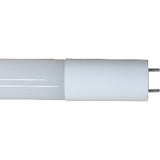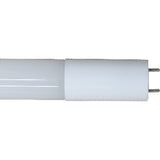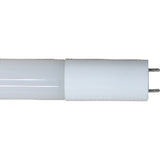LED Troffers Offer Strong Case To Replace Fluorescent
Posted by Dave on for ProLampSales
Fluorescent troffers in North America account for nearly 50% of all fixtures installed in commercial buildings such as office, retail, education and medical facilities. Troffers normally are installed in T-bar grid drop ceilings with the 2 ft. x 4 ft. configuration being the most common.
In 2018, LED troffer fixtures and troffer retrofit kits deliver over 40% higher efficacy than fluorescent – roughly 110 lm/W for LED compared to 75 lm/W for fluorescent.
This dramatic difference in efficacy plus a light source with a longer rated life and, in most cases, lumen output that provides an acceptable replacement for fluorescent, make LED troffers and LED troffer retrofits a strong candidate for facilities looking for a cost effective way to lower lighting operating costs.
This post will take a closer look at the variables that should be included when considering a move to LED troffers.
Some of the data presented in the post is from a USDOE Office of Energy Efficiency & Renewable Energy report on LED troffers, published in 2018, that provides a macro view of the current comparison between fluorescent and LED troffers. The DOE study includes all LED troffers and troffer retrofits, over 40,000 products, listed with the LED Lighting Facts program.
Key Considerations When Comparing LED to Fluorescent Troffers
Efficacy
The most common efficacy range for fluorescent troffers is between 65 lm/W and 75 lm/W. Most LED troffers achieve around 100 lm/W, while LED troffer retrofits reach slightly higher at an average of 107 lm/W.
Both of these LED efficacy levels meet the minimum Design Light Consortium (DLC) standard efficacy benchmark (QPL Technical Requirements V4.2). In addition, according to the DOE report, 17% of the troffers listed with DOE have an efficacy at or above 125 lm/W which meets the DLC Premium requirements.
With efficacy improving each year, LED troffers are approaching twice the lumen per watt values of existing fluorescent troffers.
Lumen Output
A typical 2 ft. x 4ft., 32W T8, 2-lamp, normal ballast factor fluorescent troffer produces about 3500 initial lumens. A similar 3-lamp troffer produces roughly 5400 initial lumens.
According to the DOE report, 50% of the 2 ft. x 4 ft. LED troffers surveyed had lumen output in the 3500 to 5400 lumen range.
Of course, about 50% of the LED troffers did not reach these typical lumen output levels which means buyers need to carefully compare the lumen output of various products to ensure the LED fixtures meet the specific light level needs of their application.
In addition, buyers should be aware they will find LED troffer lumen packages as high as 6,000 lumens. These fixtures, if used in 8 ft. – 10 ft. ceilings could produce significant glare.
Matching fixture light levels with the application specific requirements and accounting for lumen depreciation (mean lumens) is critical analysis when making the switch from fluorescent to LED.
Color Quality
The color rendering index (CRI) of a light source provides general information about the ability of that light source to accurately reveal the colors of objects it illuminates. The value (on a scale of 0 to 100) is based on a comparison with a natural or reference light source.
A CRI value of 80 to 82 for a light source is considered good color quality – sufficient for office, education and institutional applications that will normally use troffer style fixtures.
Compared to fluorescent troffers using newer 800 series lamps (eg. F32T8/835 which means CRI 80+ and color temperature 3500K), nearly all LED troffers and LED troffer retrofits will match the CRI values of fluorescent.
When LED will be replacing fluorescent troffers using older 700 series lamps (eg. F32T8/735 which means CRI 70+ and color temperature 3500K), all LED troffer retrofits on the market today will exceed the color quality of these older fluorescent lamps.
In addition, the color temperature (CCT) offering for virtually all LED troffers matches the typical fluorescent trio of 3000K, 3500K and 4000K.
Light Distribution
Because troffers are often used in office or educational settings where monitors are in use, a glare-free, diffuse illumination is required. Fluorescent troffers may have lenses or louvers to deliver the desired light distribution. For LED troffers, prismatic lenses are the norm. Because LED is a directional light source, a uniform prismatic lens is needed to provide diffuse light distribution.
Important note: Facility managers, contemplating an LED troffer retrofit project where an LED light module replaces the linear fluorescent lamps, should also factor in the cost of new diffusers to replace louvers if they are currently used on the existing fluorecent fixtures. If louvers are re-installed after the LED retrofit, it is unlikely the light distribution will be satisfactory.
Controls
If the existing fluorescent troffer system currently utilizes occupancy controls, it is important to confirm that the LED troffers (or retrofit troffer modules) will work with the installed controls. Many occupancy sensors (as well as dimmers and photocells), especially if they have been installed for a few years, will not effectively control LED fixtures.
Rated Life
The extended rated life of LEDs compared to most other light sources has been one of the major selling points. Longer lamp life means fewer lamp changes which can translate into significant savings on maintenance costs over the life of the system. In a return on investment analysis, maintenance savings costs may be as important or even more important than energy savings when comparing fluorescent to LED.
Newer fluorescent lamps reach 40,000 hours of rated life, but most existing fluorescent installations will be utilizing lamps in the 10,000 to 20,000 hour life range.
LED troffer fixtures generally use light engines (LED arrays, not LED T8 lamps) that offer a life of 85,000 hours and higher. These LED arrays are integrated into the fixture and in many cases are not replaceable. This means the life of the fixture is the same as the life of the light source. However, at 85,000 hours, even if the LED troffer is ON 12 hours a day every day of the year, the light source/fixture will be good for almost 20 years.
Conclusion
By 2018, LED troffers have reached a point of development where they offer an extremely compelling case for new construction projects and a very strong case for remodel and retrofit projects.
When comparing LED troffers and retrofits to fluorescent troffers, the most LED fixtures will either exceed (efficacy, lamp life) or match (color quality) the specifications of the fluorescent fixtures. LED lumen output often matches that of various fluorescent configurations but it, along with control compatibility, requires careful consideration to ensure the LED installation will meet the needs specific to the application.
- Posted in Energy Efficiency, Fluorescent, LED, Workplace
Featured Products (View All)
0 Comments




